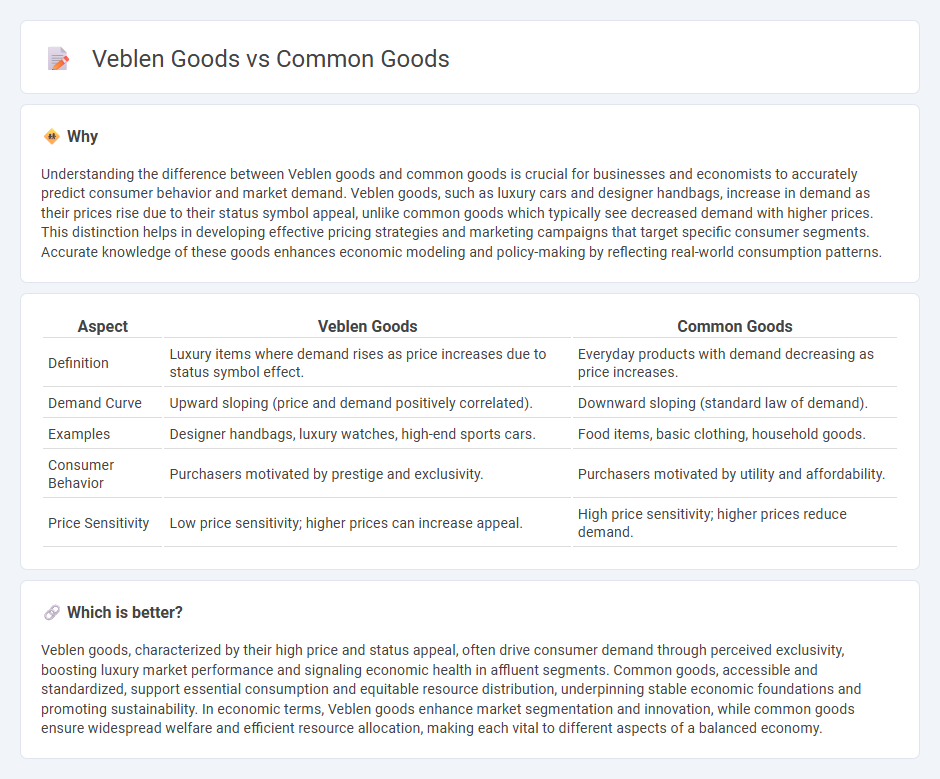
Veblen goods are luxury items for which demand increases as their price rises, driven by their status symbol appeal rather than utility, contrasting with common goods that follow typical supply and demand rules where higher prices usually decrease demand. Economic studies highlight the unique consumer behavior towards Veblen goods, emphasizing prestige and exclusivity as key factors. Explore further to understand how these distinct goods influence market dynamics and consumption patterns.
Why it is important
Understanding the difference between Veblen goods and common goods is crucial for businesses and economists to accurately predict consumer behavior and market demand. Veblen goods, such as luxury cars and designer handbags, increase in demand as their prices rise due to their status symbol appeal, unlike common goods which typically see decreased demand with higher prices. This distinction helps in developing effective pricing strategies and marketing campaigns that target specific consumer segments. Accurate knowledge of these goods enhances economic modeling and policy-making by reflecting real-world consumption patterns.
Comparison Table
| Aspect | Veblen Goods | Common Goods |
|---|---|---|
| Definition | Luxury items where demand rises as price increases due to status symbol effect. | Everyday products with demand decreasing as price increases. |
| Demand Curve | Upward sloping (price and demand positively correlated). | Downward sloping (standard law of demand). |
| Examples | Designer handbags, luxury watches, high-end sports cars. | Food items, basic clothing, household goods. |
| Consumer Behavior | Purchasers motivated by prestige and exclusivity. | Purchasers motivated by utility and affordability. |
| Price Sensitivity | Low price sensitivity; higher prices can increase appeal. | High price sensitivity; higher prices reduce demand. |
Which is better?
Veblen goods, characterized by their high price and status appeal, often drive consumer demand through perceived exclusivity, boosting luxury market performance and signaling economic health in affluent segments. Common goods, accessible and standardized, support essential consumption and equitable resource distribution, underpinning stable economic foundations and promoting sustainability. In economic terms, Veblen goods enhance market segmentation and innovation, while common goods ensure widespread welfare and efficient resource allocation, making each vital to different aspects of a balanced economy.
Connection
Veblen goods and common goods are connected through their contrasting demand dynamics and social value implications in economics. Veblen goods exhibit increased demand as their prices rise due to their status symbol appeal, reflecting a form of conspicuous consumption, whereas common goods are rivalrous and non-excludable, often leading to overuse and depletion, known as the tragedy of the commons. Their relationship highlights the interplay between consumer behavior driven by status and the management challenges of shared resources in sustaining economic welfare.
Key Terms
Rivalry (Common goods)
Common goods are characterized by rivalry, meaning one person's consumption reduces the availability for others, leading to potential depletion or congestion. Examples include fisheries, forests, and public grazing lands where resource overuse can result in scarcity. Learn more about the impact of rivalry in economic goods and resource management strategies.
Exclusivity (Common goods)
Common goods are non-excludable and rivalrous, meaning their availability is shared among many but consumption by one reduces availability for others, limiting exclusivity. Unlike Veblen goods, which derive value from exclusivity and high status, common goods emphasize accessibility and communal use rather than rarity or luxury. Explore how the concept of exclusivity shapes different market dynamics and consumer behavior.
Conspicuous consumption (Veblen goods)
Conspicuous consumption highlights Veblen goods, which gain value as their price increases, serving as status symbols unlike common goods that have typical demand-price relationships. Veblen goods often include luxury items such as designer handbags, sports cars, and high-end watches, emphasizing social prestige over functional utility. Explore how conspicuous consumption drives economic behavior and influences market trends in luxury sectors.
Source and External Links
Common good (economics) - Common goods are economic goods that are rivalrous (consumption by one reduces availability for others) and non-excludable (no one can be prevented from consuming them), such as fish stocks and forests.
Common good - The common good refers to what is broadly beneficial to all or most members of a society, often addressed through collective action to serve public benefit, which can include health interventions, public safety, and shared social welfare.
Common Goods Thrift Store - Common Goods is a thrift store community project offering affordable, high-quality secondhand goods to support local families and reduce landfill waste.
 dowidth.com
dowidth.com